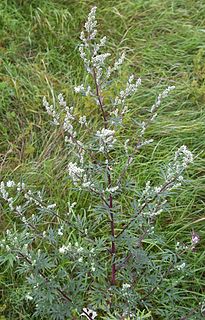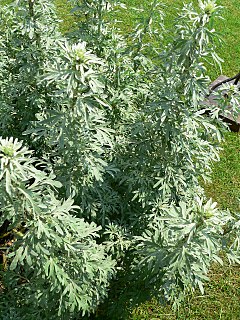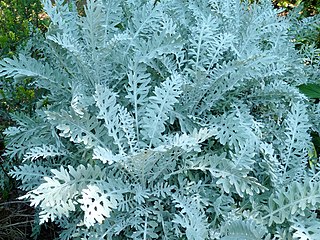
Artemisia is a large, diverse genus of plants with between 200 and 400 species belonging to the daisy family Asteraceae. Common names for various species in the genus include mugwort, wormwood, and sagebrush.

Artemisia vulgaris, the common mugwort, is a species of flowering plant in the daisy family Asteraceae. It is one of several species in the genus Artemisia commonly known as mugwort, although Artemisia vulgaris is the species most often called mugwort. It is also occasionally known as riverside wormwood, felon herb, chrysanthemum weed, wild wormwood, old Uncle Henry, sailor's tobacco, naughty man, old man, or St. John's plant. Mugworts have been used medicinally and as culinary herbs.

Pinus densiflora, also called the Japanese red pine, the Japanese pine, or Korean red pine, has a home range that includes Japan, the Korean Peninsula, northeastern China and the extreme southeast of Russia. This pine has become a popular ornamental and has several cultivars, but in the winter it becomes yellowish. The height of this tree is 20–35 metres. The plant prefers full sun on well-drained, slightly acidic soil.

Artemisia annua, also known as sweet wormwood, sweet annie, sweet sagewort, annual mugwort or annual wormwood, is a common type of wormwood native to temperate Asia, but naturalized in many countries including scattered parts of North America.

Artemisia absinthium is a moderately poisonous species of Artemisia native to temperate regions of Eurasia and North Africa, and widely naturalized in Canada and the northern United States. It is grown as an ornamental plant and is used as an ingredient in the spirit absinthe and some other alcoholic beverages.

Euonymus japonicus is a species of flowering plant in the family Celastraceae, native to Japan, Korea and China. It is an evergreen shrub or small tree growing to 2–8 m tall, with opposite, oval leaves 3–7 cm long with finely serrated margins. The flowers are inconspicuous, greenish-white, 5 mm diameter. In autumn, orange fruit hangs below the flaring pink seed coverings.

Mugwort is a common name for several species of aromatic flowering plants in the genus Artemisia. In Europe, mugwort most often refers to the species Artemisia vulgaris, or common mugwort. While other species are sometimes referred to by more specific common names, they may be called simply "mugwort" in many contexts.

Acer japonicum, the Amur maple, downy Japanese-maple or fullmoon maple, is a species of maple native to Japan, on Honshū, Hokkaidō, Kyūshū, and also southern Korea.

Centaurea cineraria, the velvet centaurea, is – like some other plants – also known as dusty miller and silver dust. It is a small plant in the family Asteraceae and originates from the Island of Capraia in Italy, where it is called fiordaliso delle scogliere.

Spiraea japonica, the Japanese meadowsweet or Japanese spiraea, is a plant in the family Rosaceae.

Artemisia pycnocephala is a North American species of sagebrush in the sunflower family, known by the common names beach wormwood, sandhill sage, and coastal sagewort.

Artemisia campestris is a common and widespread species of plants in the sunflower family, Asteraceae. It is native to a wide region of Eurasia and North America. Common names include field wormwood, beach wormwood, northern wormwood, Breckland wormwood, boreal wormwood, Canadian wormwood, field sagewort and field mugwort.

Artemisia ludoviciana is a North American species of flowering plant in the daisy family Asteraceae, known by several common names, including silver wormwood, western mugwort, Louisiana wormwood, white sagebrush, and gray sagewort.

Artemisia michauxiana is a North American species of wormwood in the sunflower family. It is known by the common names Michaux's wormwood and lemon sagewort. It is native to the western United States and Canada. It grows in mountain talus habitats in subalpine to alpine climates.
Valerie Finnis (1924–2006) was a well-known British photographer, lecturer, teacher and gardener.

Artemisia tilesii is an Asian and North American species of flowering plant in the aster family. Its common names include Tilesius' wormwood, Aleutian mugwort, and stinkweed. It is native to Russia, Japan, and northern North America.

Artemisia arborescens, the tree wormwood, is a species of flowering plant in the family Asteraceae, native to the Mediterranean region. It is an erect evergreen perennial, with masses of finely-divided aromatic silvery-white leaves and single-sided sprays of yellow daisy-like flowers. This plant is cultivated for its foliage effects, but in colder temperate regions it requires the protection of a wall.

Artemisia schmidtiana, common name silvermound, is a species of flowering plant in the family Asteraceae, native to Japan but widely cultivated as an ornamental.
Artemisia globularia, the purple wormwood, is a rare Asian and North American species of plants in the sunflower family. It is native to Alaska, Yukon Territory, and the Chukotka Autonomous Okrug of Russia.
Artemisia senjavinensis, the arctic wormwood, is a rare Arctic species of plants in the sunflower family. It has been found only on the Seward Peninsula on the Alaskan side of the Bering Strait and on the Chukotka (Chukchi) Peninsula on the Russian side.

















